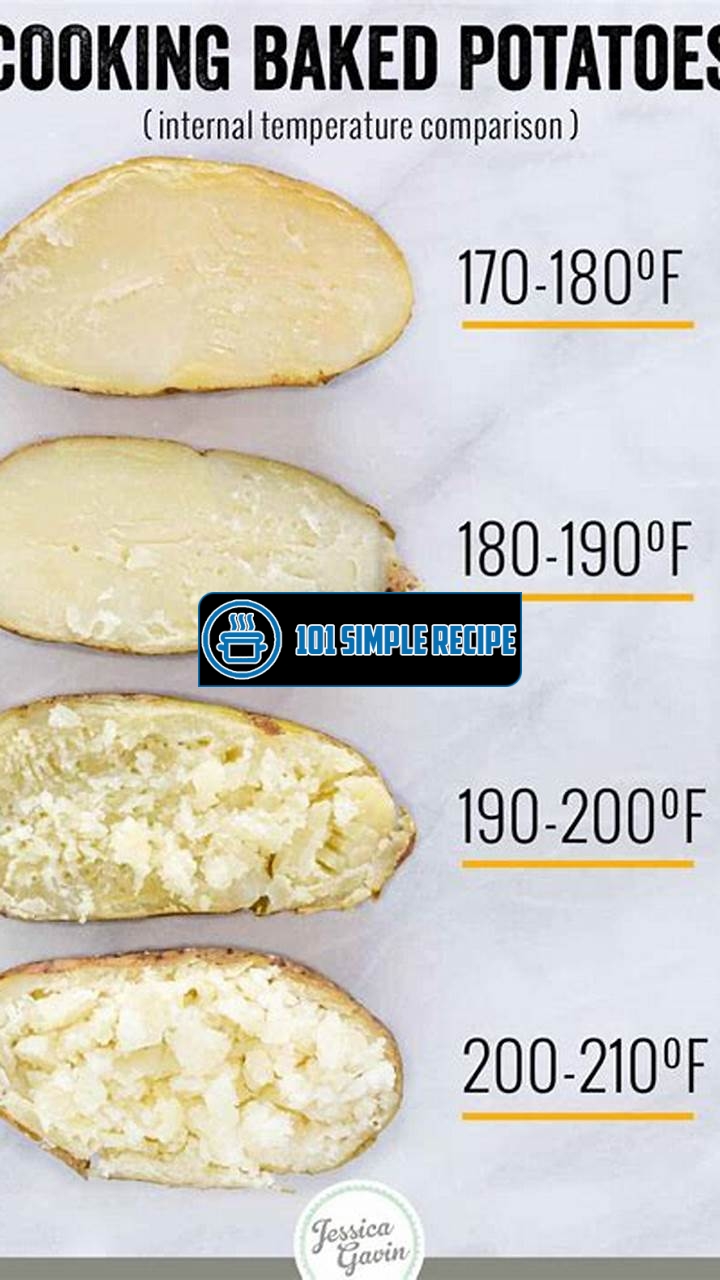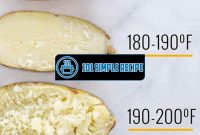Are you tired of ending up with an undercooked or overcooked baked potato? Look no further – we have the answer! Discover the ideal baked potato temperature for perfection and elevate your culinary skills to a whole new level. ✨ By understanding the science behind baking the perfect potato, you can achieve a crispy skin with a fluffy, tender interior every time. So, let’s dive in, explore the secrets to achieving potato perfection, and wow your taste buds with this simple yet delightful dish.

Understanding Proper Baked Potato Temperature
When it comes to achieving the perfect texture and flavor in baked potatoes, understanding the proper temperature is key. Baking potatoes at the correct temperature ensures that they cook evenly and thoroughly, resulting in a delicious and satisfying dish. So, let’s delve deeper into why temperature matters, how to choose the right oven temperature, and the importance of preheating your oven.
Why Temperature Matters
Temperature plays a crucial role in the outcome of your baked potatoes. Cooking them at the proper temperature allows the heat to penetrate evenly and cook the potatoes thoroughly. If the temperature is too low, the potatoes may not cook through, leaving them hard and undercooked in the center. On the other hand, if the temperature is too high, the outside of the potatoes may burn before the inside has a chance to cook properly. Finding the ideal temperature ensures that your potatoes are tender on the inside with a perfectly crisp skin.
Choosing the Right Oven Temperature
So, what is the ideal temperature for baking potatoes? In general, a temperature of 400°F (200°C) works well for most recipes. This temperature allows the potatoes to cook through without becoming overly browned or burnt on the outside. However, if you prefer a quicker cooking time and a crispier skin, you can increase the temperature to 425°F (220°C). Just keep in mind that a higher temperature may require you to adjust the cooking time accordingly to avoid overcooking.
Tip: It’s always a good idea to refer to your specific recipe, as some recipes may require slightly different temperatures based on the cooking time and desired outcome.
Preheating Your Oven
Preheating your oven is an essential step for achieving the perfect baked potatoes. Preheating allows the oven to reach the desired temperature before you place the potatoes inside. This ensures that the potatoes start cooking immediately at the right temperature, resulting in a more even and consistent bake.
To preheat your oven, simply set it to the desired temperature and allow it to heat up for about 10-15 minutes. This gives the oven enough time to reach the correct temperature. Once the oven has preheated, you can place your prepared potatoes on a baking sheet and place them in the oven for the specified cooking time.
Note: Keep in mind that oven temperatures may vary, so it’s a good idea to use an oven thermometer to ensure accuracy.
In conclusion, understanding the proper baked potato temperature is crucial for achieving the perfect texture and flavor. By cooking your potatoes at the right temperature, choosing the appropriate oven temperature, and preheating your oven, you’ll have mouthwatering baked potatoes with a fluffy interior and a crispy skin. So, fire up that oven, set the temperature, and get ready to enjoy the absolute perfection of a well-baked potato!
Factors Affecting Baked Potato Temperature
In order to achieve the perfect baked potato, there are several factors that can affect the baking time and temperature. By understanding these variables, you can ensure that your baked potatoes turn out just right every time. Let’s explore the different factors that come into play.
Size and Thickness of Potatoes
The size and thickness of the potatoes you choose to bake play a significant role in determining the ideal temperature. Larger potatoes will naturally take longer to cook, while smaller ones will require less time. Additionally, the thickness of the potato skin can also affect the baking time. Thicker skins may take longer to cook through, so it’s important to adjust the temperature accordingly. Generally, for medium-sized potatoes with average thickness, a temperature of around 400°F (200°C) works well.
Type of Oven
Your choice of oven can greatly impact the temperature required for baking potatoes. Different types of ovens have varying heat distribution and temperature accuracy. Gas ovens tend to have more fluctuations in temperature compared to electric ovens, which have more precise temperature control. If you’re using a gas oven, it may be necessary to increase the temperature slightly to compensate for any heat loss. Conversely, if you’re using an electric oven, a slightly lower temperature may suffice. It’s always a good idea to preheat your oven to ensure consistent heat throughout the baking process.
Altitude and Climate
Believe it or not, the altitude at which you are baking your potatoes can affect the ideal baking temperature. Higher altitudes generally have lower atmospheric pressure, which results in lower boiling points for water. This means that at higher altitudes, water evaporates more quickly, potentially leading to drier, undercooked potatoes. Consequently, if you’re baking at a high altitude, you may need to increase the temperature and baking time to compensate for the lower boiling point of water. Similarly, the climate in your area can also impact the baking time and temperature. In hot and humid climates, the excess moisture in the air can slow down the baking process, requiring you to adjust the temperature and extend the cooking time.
Understanding the various factors that can affect the temperature at which you bake your potatoes is essential for achieving the perfect result. By considering the size and thickness of the potatoes, the type of oven you’re using, and the altitude and climate in your area, you can make the necessary adjustments to ensure your baked potatoes come out just the way you like them – perfectly cooked and irresistibly delicious.
Recommended Baked Potato Cooking Temp and Time
When it comes to achieving the perfect baked potato, the temperature and cooking time play a crucial role in determining the outcome. A fluffy interior with a crispy skin is the ultimate goal, and by following the recommended guidelines, you can achieve potato perfection. Whether you prefer the traditional method, a rapid approach, or a slow-cooked option, finding the ideal baked potato temp is essential for culinary success.
Traditional Baked Potato Temp and Time
For those who appreciate the classic approach, the traditional baked potato method is tried and true. Preheat your oven to 400°F (approximately 200°C) for a perfectly cooked potato. This temperature allows the potato to cook evenly and thoroughly, resulting in a soft and fluffy interior.
Place the scrubbed and dried potatoes directly on the oven rack or on a baking sheet. This allows the skin to crisp up nicely. Bake for approximately 60-75 minutes, depending on the size of the potatoes. Keep in mind that larger potatoes may require additional time to cook through.
Remember, selecting potatoes of equal size ensures an even baking process, so try to choose potatoes that are similar in size to achieve consistent results.
Rapid Baked Potato Method
When time is of the essence, the rapid baked potato method is a game-changer. By increasing the temperature, you can significantly reduce the cooking time without sacrificing taste or quality.
Preheat your oven to 450°F (approximately 230°C) and prepare your potatoes by washing and drying them thoroughly. Use a fork to poke several holes in each potato. This allows steam to escape and prevents the potato from bursting.
Wrap each potato in aluminum foil and place them directly on the oven rack. Bake for approximately 30-40 minutes, or until the potatoes are tender when pierced with a fork. The high temperature ensures a crispy skin while maintaining a fluffy interior.
Don’t forget to remove the foil during the last 10 minutes of baking to allow the skin to crisp up properly.
Slow-Cooked Baked Potatoes
If you’re a fan of exceptionally tender and flavorful potatoes, the slow-cooked method is worth considering. Although it requires more time, the end result is well worth the wait.
Preheat your oven to 325°F (approximately 165°C). Wash and dry the potatoes, and then rub them with a small amount of olive oil. Sprinkle each potato with salt to enhance the flavors during the slow cooking process.
Place the potatoes directly on the oven rack and bake for approximately 90-120 minutes. The low temperature allows the potatoes to cook slowly, resulting in an incredibly soft and succulent interior. The skin may not be as crispy as with other methods, but the trade-off is the melt-in-your-mouth texture.
Keep in mind that cooking times may vary depending on the size and type of potatoes used, so always check for doneness by gently squeezing the potato. It should yield to pressure and feel soft inside.
By understanding the recommended baked potato temp and cooking times for each method, you can take your culinary skills to the next level. Whether you opt for the traditional, rapid, or slow-cooked approach, you’ll be well on your way to achieving potato perfection every time.
How to Measure Baked Potato Temperature
Discover effective techniques for determining if your baked potatoes are fully cooked and safe to eat.
Using a Food Thermometer
When it comes to achieving the ideal baked potato temperature, using a food thermometer is the most accurate method. This handy tool allows you to measure the internal temperature of the potato, ensuring it is cooked to perfection. To use a food thermometer, simply insert the probe into the thickest part of the potato without touching the skin. Wait a few seconds for the temperature reading to stabilize, and voila! You now have an accurate measurement of the potato’s internal temperature.
️Pro tip: The ideal internal temperature for a baked potato is around 210°F (99°C). This ensures that the potato is fully cooked and soft on the inside.
Testing with a Fork
If you don’t have a food thermometer on hand, you can also use a fork to test the doneness of your baked potato. Simply insert a fork into the potato and gently twist it. If the fork slides in easily and the potato feels tender, it is most likely fully cooked. However, if there is resistance or the potato feels firm, it needs more time in the oven.
Remember: While using a fork can give you a rough idea of the potato’s doneness, it may not provide the same level of accuracy as a food thermometer. It’s always best to use a combination of methods to ensure your baked potato is thoroughly cooked.
Visual Cues for Doneness
In addition to using a food thermometer or fork, you can also rely on visual cues to determine if your baked potato is cooked to perfection. One telltale sign of a fully cooked potato is the softness of the skin. If it easily gives when gently pressed, it is likely done. Another visual cue is the appearance of the potato’s flesh. A baked potato that is fully cooked will have a fluffy and light texture, whereas an undercooked potato may have a denser consistency.
Keep in mind: While visual cues can be helpful, they are not foolproof. It’s always recommended to use a food thermometer for accurate measurements, especially if you’re unsure about the potato’s doneness.
To sum it up, measuring the baked potato temperature is essential to ensure it is fully cooked and safe to eat. Make use of a food thermometer for precise results, or employ alternative methods like testing with a fork or relying on visual cues. By following these techniques, you’ll be able to enjoy the ideal baked potato with confidence.
Troubleshooting Common Issues with Baked Potato Temperature
When it comes to preparing the perfect baked potato, finding the ideal temperature is crucial. The right balance ensures that your potato is cooked through, with fluffy insides and a crispy skin. However, sometimes things don’t go as planned, and you may encounter common issues with baked potato temperature. In this article, we will address these problems and provide you with solutions to achieve potato perfection.
Undercooked Potatoes
One of the most frustrating issues with baked potatoes is when they come out undercooked. This often happens when the temperature is too low or when the cooking time is insufficient. To remedy this situation, try the following solutions:
- Increase the temperature: If your potatoes are consistently undercooked, it may be time to adjust the temperature. Increase it by 25°F (14°C) and monitor the cooking time accordingly. This extra heat will help ensure that the potatoes are fully cooked.
- Extend the cooking time: If raising the temperature doesn’t solve the issue, try extending the cooking time. Adding an extra 10-15 minutes to the baking time can make a significant difference. Remember to always check for doneness by inserting a fork into the potato. It should glide in smoothly without any resistance.
- Precook the potatoes: Another method to prevent undercooked potatoes is to partially cook them before baking. You can microwave them for a few minutes to jumpstart the cooking process. Once partially cooked, transfer them to the oven for the final baking. This technique ensures that the potatoes cook evenly and thoroughly.
Overcooked Potatoes
On the other end of the spectrum, overcooked potatoes can be equally disappointing. When potatoes are overcooked, they become mushy and lose their desirable texture. Here are some solutions to rectify this issue:
- Decrease the temperature: If you find that your potatoes are consistently overcooked, it’s time to lower the temperature. Reduce it by 25°F (14°C) to prevent the potatoes from cooking too quickly and becoming mushy.
- Shorten the cooking time: Overcooked potatoes may be the result of leaving them in the oven for too long. To avoid this, reduce the overall cooking time. Start checking for doneness earlier and remove the potatoes from the oven as soon as they are tender. This will help you achieve the desired texture without overcooking them.
- Parboil the potatoes: Parboiling the potatoes before baking can help you prevent overcooking. Boil the potatoes for a few minutes until they are partially cooked, then transfer them to the oven. This will allow you to shorten the overall cooking time, reducing the risk of ending up with mushy potatoes.
Unevenly Cooked Potatoes
Unevenly cooked potatoes can be frustrating because some parts may be undercooked while others are fully cooked. Achieving even cooking can be a bit challenging, but these solutions can help:
- Choose uniform-sized potatoes: When baking multiple potatoes, make sure they are of similar size. This will help promote even cooking, as all potatoes will require the same amount of time to cook.
- Wrap the potatoes in foil: Wrapping the potatoes in foil before baking can help distribute the heat more evenly. The foil acts as an insulator and prevents certain areas from getting too much heat. Just remember to prick the potatoes with a fork before wrapping to allow steam to escape.
- Flip the potatoes halfway through: To ensure even cooking, flip the potatoes midway through the baking process. This will allow both sides of the potato to receive equal heat exposure, resulting in a consistently cooked potato.
With these troubleshooting tips, you’ll be well-equipped to overcome common issues with baked potato temperature. Whether your potatoes are undercooked, overcooked, or unevenly cooked, the solutions provided will help you achieve potato perfection. So go ahead and confidently serve up delicious baked potatoes that are cooked to perfection every time!
Thank you for taking the time to read our article on baked potato temperature. We hope you found the information helpful and that it will guide you in achieving perfectly cooked baked potatoes every time. If you have any further questions or would like to learn more about other cooking techniques, please visit us again later. Happy cooking!
Frequently Asked Questions
Here are some frequently asked questions about baked potato temperature:
| No. | Questions | Answers |
|---|---|---|
| 1. | What temperature should I bake potatoes at? | For fluffy and tender baked potatoes, bake them at 400°F (200°C) for approximately 45-60 minutes. Adjust the time according to the size of the potatoes. |
| 2. | How do I know when a baked potato is done? | You can test the doneness of a baked potato by inserting a fork or knife into it. If it slides in easily without resistance, the potato is done. |
| 3. | Can I bake potatoes at a lower temperature for a longer time? | Yes, you can bake potatoes at a lower temperature of 350°F (175°C) for a longer time of about 60-90 minutes. This will result in a softer skin and slightly different texture. |
| 4. | Can I bake potatoes at a higher temperature for a shorter time? | Baking potatoes at a higher temperature, such as 450°F (230°C), can help achieve a crispy and golden skin. However, you may need to reduce the baking time to around 30-40 minutes. |
| 5. | Should I wrap potatoes in foil when baking? | While wrapping potatoes in foil can help retain moisture, it also steams the potatoes, resulting in a softer skin. If you prefer a crispy skin, bake the potatoes without foil. |
| 6. | Can I microwave potatoes instead of baking them? | Yes, you can microwave potatoes for a quicker cooking time. Pierce the potatoes with a fork and microwave on high for 5-10 minutes, or until tender. However, the texture and flavor may differ from traditional baked potatoes. |
Baked Potato Temperature – Perfectly Cooked Potatoes Every Time
Now that you have all the essential information about baked potato temperature, you can confidently prepare delicious and fluffy potatoes to enjoy as a side dish or a main course. Remember to preheat your oven to 400°F (200°C) and adjust the baking time based on the size of your potatoes. Test the doneness by inserting a fork or knife, and once it slides in easily, your potatoes are ready to be served. Whether you prefer a crispy skin or a softer texture, this versatile dish is a crowd-pleaser. Experiment with different toppings and enjoy the delightful flavors of perfectly cooked baked potatoes. Visit us again for more helpful cooking tips and recipes. Happy cooking!
Jump to Recipe
Baked Potato Temperature – Perfectly Cooked Potatoes Every Time

Learn the ideal temperature to bake potatoes to achieve fluffy and perfectly cooked results every time. Whether you prefer a crispy skin or a softer texture, this guide will help you master the art of baking potatoes.
- 4 large Russet potatoes
- 2 tablespoons olive oil
- Salt and pepper to taste
- Preheat your oven to 400°F (200°C).
- Wash and scrub the potatoes thoroughly. Pat them dry with a paper towel.
- Rub each potato with olive oil, ensuring they are evenly coated. Sprinkle salt and pepper to taste.
- Place the potatoes on a baking sheet or directly on the oven rack. Bake for 45-60 minutes, or until a fork inserts easily into the potatoes.
- Remove the potatoes from the oven and let them cool for a few minutes. Slice each potato lengthwise, and serve with your favorite toppings such as sour cream, bacon, or chives.






